1 Introduction
Simple estimates of wave kinematic and dynamic parameters are frequently used in feasibility studies of coastal constructions and shore protection measures. Overestimation of wave parameters and dynamics can increase project costs significantly, whereas underestimation can cause catastrophic collapse of structures and loss of life. Although many methods exist to estimate wave characteristics in different conditions, most are only applicable to certain waves and depth ranges and require input values that are difficult to determine accurately or necessitate the use of complex mathematics(Stokes,1847). To analyze the performance of a ship hull on the sea surface is one of the important subjects in basic hydrodynamics and attracted by a number of researchers. When a ship hull is sailing on the sea, the free surface effect should be considered including evaluations of the free surface profile, pressure distribution, wave profile, lift and drag as well. This paper is concerned with the wave generation due to the flow around a ship hull moving on the free surface. The use of laboratory experiments can be an alternative. However, the role of scaling factors for dissipation mechanisms due to wave breaking, turbulence and generation of eddies in the fluid region are not well established in the physical tests and are of great importance in the present case. The use of numerical models based on the two-phase flow N-S models appears as an alternative to experimental techniques as the number of simplifying assumptions present in the equations is lower than in other approaches.Kouh et al.(2002)analyzed performance of 2D hydro-foil under free surface. They distributed source on undisturbed free surface and doublet on foil and wake surface. Dirichlet type body boundary condition is used instead of Neumann-type boundary condition, the free surface condition is linearized by free stream potential.Teng and Kato(2002), Zhang and Beck(2008)gave high order wave force on axisymmetric bodies and body motions in waves. In these work, surface waves were contained and could be very useful for the ship hull's design and optimization.Bai and Eatock(2009)studied wave interaction with fixed and floating flares structures using high order wave theory. Coupled with surface effect, Ashgriz et al.(2004), Sitanggang et al.(2006)presented the wave-surface interaction.Chen and Liu(2005)used submerged vortex lattice method for calculation of the flow around hydrofoil. They distributed the doublet on a sub-surface inside the body(desingularity method).Guignard et al.(1999)set up numerical wave tank coupled with BEM and volume of fluid(VOF) and calculated the wave's collapse. But the calculating of this model was not synchronous. In the matching boundary, a time sequence could be obtained through former domain(BEM) and then set as the inlet boundary of the later domain(VOF). Meanwhile, in the transmission of the matching boundary, there was only the direction of backwards and there was not the forward direction, so the model was called "weak couple". Using Guignard's model, Grill et al.(2004)studied the solitary wave's propagation and collapse on the slope.Chen and Lee(1996)set up a numerical model coupled with BEM and VOF. He divided the computing domain into two separated parts. The upper fluid layer was controlled by Laplace equations and the lower layer was controlled by N-S equations. The viscosity flow around a ship hull was then calculated. As the action of the wave for the structure was mainly on the surface, this model had faults on dealing with the loading on the structure.
Stokes wave theory is the most popular theory in the sea.Constantin et al.(2004, 2006, 2007)studied the vortex characters in Stokes waves.Herry(2006, 2008)studied the Lagrange movement and all these studies indicates that Stokes wave theory coupled with VOF model is a promising way in the coastal science. The hydrodynamic performance of the ship related with the wave was also studied.Cao(2008)computed and simulated the sailing of the planning vessel on the still water surface and compared the resistance results with the experimental and theoretical results. A preliminary research on the planning vessel performance under the waves was also conducted.Wang et al.(2009)used the CFD method to simulate tail flow condition of the planning vessel and its resistance was calculated and compared with the experimental values. In numerical tank, Dong and Huang(2004), Li et al.(2010)made nonlinear simulation between waves and floating body.Lara et al.(2006)solved the three-dimensional Navier-Stokes equations using a finite volume discretization. The free surface is tracked using a second-order reconstruction algorithm together with the VOF method. The model also considered porous media flow. A new set of volume-averaged Reynolds-averaged Navier-Stokes equations(VARANS)had been implemented. Some works byLi et al.(2005) andChristensen(2006)showed applications of LES(large eddy simulation)to wave breaking. Since the LES results represented only a single realization of turbulent flows, it was difficult to directly compare LES results with experimental data. Moreover, LES required analyzing three-dimensional flows and normally dem and ed a fine grid resolution. Thus the suitable computational domain was still quite small.
In recent years, there is a trend to couple the modeling of complicated wave transformation with the analysis of hydrodynamics and body motion. Furthermore, efforts are also made to develop general-purpose models that can be applied to not only water wave problems but also many other types of turbulent free surface flow problems. In the following discussion, numerical simulations are performed to the Stokes wave coupled with VOF multiphase model to demonstrate the mutual coherence of the waves and the dynamics. However, it should be stressed that field relationships may be very different due to a combination of factors such as air and water, wave interference, or ocean currents. Therefore, relatively little comparison with wave propagation and fluid particle is attempted. The proposed methodology is intended to serve as a basis for further studies incorporating these elements.
2 Theoretical formulation2.1 N-S equations
The viscous flow field around a ship hull is simulated with Reynolds averaged Navier-Stokes(RANS)equation. This RANS equation needs Reynolds stress
 to be appropriately modeled. The governing equation of the flow field and mathematical expression of turbulence model are described.
to be appropriately modeled. The governing equation of the flow field and mathematical expression of turbulence model are described.
The RANS equations in Cartesian tensor notation can be expressed as:


Boussinesq hypothesis can be used to relate the Reynolds stresses to the mean velocity gradients as follows:

The advantage of this approach is the relatively low computational cost associated with the computation of the turbulent viscosity μt.
2.2 VOF modelThe tracking of the interface(s)between the phases is accomplished by the solution of a continuity equation for the volume fraction of one(or more)of the phases. For the qth phase, this equation has the following form:

The primary-phase volume fraction will be computed based on the following constraint:

The generalized expression for wave profiles for higher order theories(second to fifth order)is

The generalized expression for the associated velocity potential for shallow/intermediate waves is


The wave frequency ω is defined as



The surface fluctuations and velocities of Stokes wave in wave-making region can be obtained with






In this study, the Stokes wave is generated in the inlet, and at the same time, the liquid and gas phase are computed on the free surface coupled with the Stokes wave. For coupling between the wave and flow the wave inlet boundary conditions are set at the same time, at the interface, and the wave boundary condition is also set on the interpolation cells. So the air and water phase can wave separately and at the interface the interpolation is used. For the qth continuity equation

From the continuity equation, equation(4) and (5), and
 so the qth phase momentum balance is
so the qth phase momentum balance is

The three-dimensional implicit finite volume method(FVM)is applied to solve(RANS)equation. The realizable k-ε turbulence model has been implemented to capture turbulent flow around the ship hull. VOF method has been used to determine the free surface effect of water. The SIMPLEC algorithm is employed for coupling between velocity and pressure. The second order upwind scheme is applied for discretization of momentum, volume fraction, turbulent kinetic energy, and turbulent dissipation rate.
The different boundaries of the domain such as: inlet, outlet, upper, and bottom are defined. The whole computational domain is 13 m × 7 m × 3 m in length(X direction), width(Y direction) and height(Z direction). The ship hull model is optimized Wigley ship and the ship hull's length is 2.5 m and the Froude number is 0.3.Fig. 1 andFig. 2 show the schematic diagram of numerical simulation and the grid of the computational domain of the ship hull and free surface near the ship hull. Near the ship hull, the mesh is tetrahedron and the far field mesh of the computing domain is hexahedron. Fine meshing is applied near the free surface and the ship hull.

|
| Fig. 1 Schematic diagram of the numerical simulation |

|
| Fig. 2 Grid of the computational domain of the ship hull and free surface |
Numerical results are presented which illustrate the properties of solutions of the theoretical and numerical model equations and the capabilities of the numerical simulation strategy. In particular, the nonlinear Stokes wave equations show how the numerical scheme can be used to stably compute surface water waves. Artificial beach techniques have been employed to dissipate or damp out the waves at the end of the model. Since the reflected wave from forwarding ship hull model is an optimized Wigley model it has the wonderful streamline. On the inlet boundary and the forwarding ship hull little reflection in the simulation is observed, which means it can be neglected. On the left and right boundary of the tank, the boundary condition is set as the second type boundary condition. That is, the gradient of the variables is zero, so the reflection on the left and right boundaries is also not considered.Fig. 3 shows the damping zone of the numerical tank on the right side without the ship hull.
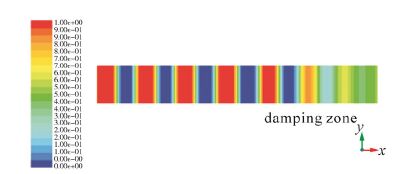
|
| Fig. 3 Damping zone of the artificial beach |
To analyze and validate the effectiveness of wave making and absorbing of numerical beach, the three dimensional Stokes wave is simulated in this paper.Fig. 4 is the convergence investigation of this paper and it can be seen that as the transient state the results are convergent and convinced. The mesh size and the time step size are critical for achieving convergent results.Fig. 5 shows the grid independence for the simulation. In this study, the average outlet pressure is monitored and the numerical error is less than 0.15% and the grid number of 2.46 million is chosen. The time step is set as 0.005 s, about 1/2000 of the whole flow time.Fig. 6 is the wave profile on the free surface.Fig. 6(a)is the wave amplitude profile time history andFig. 6(b)is the dynamic pressure along the distance. At the same time, Stokes theoretical results in the time sequence(dotted red line)are given. There is some consistency between the numerical value and the theoretical value, which shows the validity of the numerical model.Fig. 6(b)also gives the validity in the spatial scale. The numerical model was evaluated in both time and spatial scale. In this study, the volume fraction of liquid phase Vf = 0.5 is defined as the wave surface. It can be seen in the figure that the Stokes wave accords with theoretical wave profile and satisfies the computation needs.
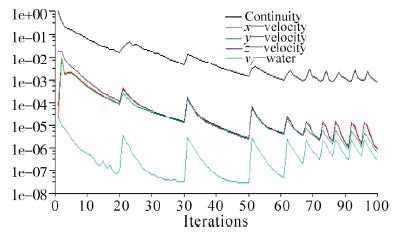
|
| Fig. 4 Convergence investigation |

|
| Fig. 5 Grid independence(a)The wave amplitude profile time history(b)The dynamic pressure along the distance |
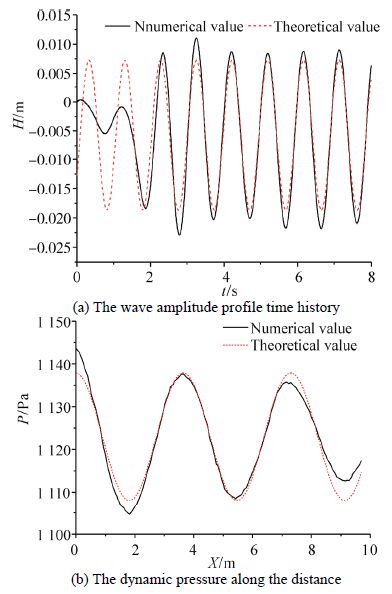
|
| Fig. 6 Numerical and theoretical wave profile on the free surface |
As for the flow velocity of 1.5 m/s, Stokes wave length 0.85 m and wave height 0.0385 m are selected andFig. 7 shows the wave profile of the free surface. Since the model is to represent flow conditions the wave character istics and air-water phase distribution need to take into consideration the interaction between the wave and the flow. Moreover, the flow and the wave act on the ship hull as well as interaction between the ship hull and the flow and wave. Meanwhile, the phase fraction of the free surface around the ship hull is specified inFig. 7 andFig. 8 for a specific moment in time(10 s).
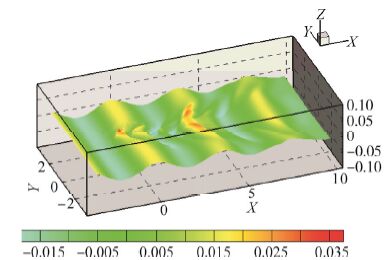
|
| Fig. 7 Waves of the free surface |
In this study, the Stokes wave theory coupled with VOF model is applied.Fig. 7 andFig. 8 display the wave character istics together. Generally, Fig. 7 shows the waves' propagation andFig. 8 shows the air and water distribution on the original wave surface(Z=0). The propagation time is 10 s and the wave just arrives at the outlet. Obviously, at the end of the computational zone the wave becomes a little flat and the phase also mixed for the action of fluid damping and artificial beach.
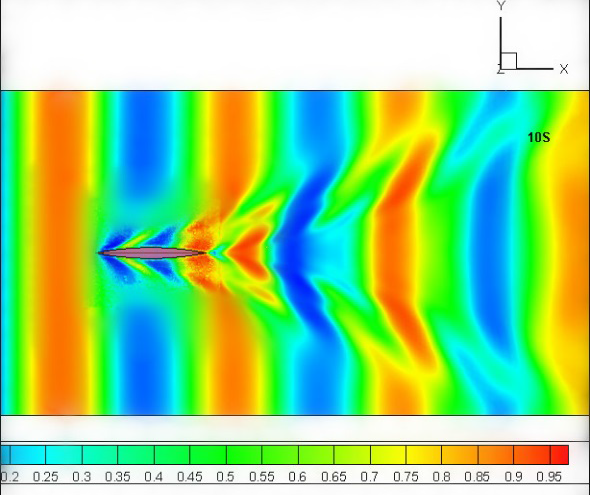
|
| Fig. 8 Phase fraction of the free surface |
The flow profiles on the free surface are illustrated inFig. 9 for the pressure andFig. 10 for the vertical velocity. As for velocity of the fluid, only the velocity in the vertical direction can cause the exchange of the air and water, so only vertical velocity is discussed.

|
| Fig. 9 Pressure along the wave propagation |
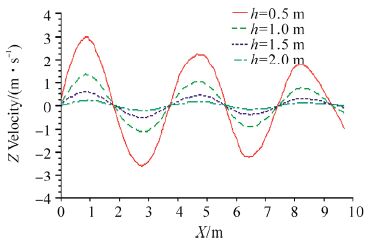
|
| Fig. 10 Vertical velocity along the wave propagation |
The vertical velocity of the fluid particle waves as the Stokes wave propagates and the amplitude also decreases as that in the propagation direction. Under the action of Stokes waves on the sea, the interface between the air and the water also waves at the same regular pattern and so does the pressure and the vertical velocity. For the pressure, there is a reducing trend and it can be concluded for the viscosity damping in the current numerical tank. As the water depth increases, the amplitude of the vertical velocity wave decreases. While the amplitude of the pressure and vertical velocity decreases because of the viscosity damping.
By using a six degrees of freedom model, the ship hull's movement is numerically solved with the Stokes wave together. Considering the wave propagation direction and computing cost only two degrees of freedom, pitch and heave of the ship hull are illustrated.Fig. 11 is the pitch of the ship hull andFig. 12 is the heave. In the current simulation, under the action of Stokes wave and free surface effect, the ship hull pitches and heaves in the similar way in the simulation. However, under the Stokes wave and flow velocity the amplitude of the heave is less than ± 0.02 m. Comparing with the wave height 0.0385 m, although the ship hull moves in the same way as the wave, the amplitude of the ship hull's heave is less than the wave height because of the viscosity damping.
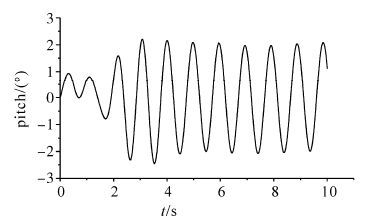
|
| Fig. 11 Pitch of the ship hull |
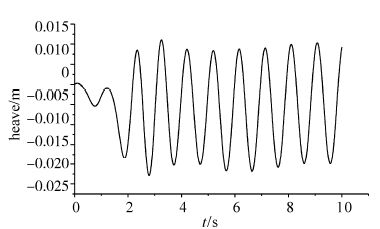
|
| Fig. 12 Heave of the ship hull |
In the present paper, the Stokes wave theory incorporating the volume of fluid(VOF)method is applied numerically to predict surface water waves caused by a moving ship hull. The realizable k-ε turbulence model has been implemented to capture turbulent flow around the ship hull in the free surface zone. Many effective conclusions can be drawn from this study. The three-dimensional implicit finite volume method is successful for analyzing the of flow around a ship hull. The volume of fluid(VOF)method along with realizable k-ε turbulence model and the Stokes wave theory can satisfactorily predict waves generated by the flow around a ship hull moving near free surface. Under the action of Stokes waves on the sea, the interface between the air and the water also waves at the same regular pattern and so does the pressure and the Z-velocity. The ship hull moves in the same way as the wave and the amplitude of the ship hull's heave is less than the wave height because of the viscosity damping.
| Bai W, Eatock Taylor R (2009). Fully nonlinear simulation of wave interaction with fixed and floating flares structures. Ocean Engineering, 36, 223-236. |
| Cao Hongjian (2008). The computation and research on resistance of planning craft based on the software FLUENT. M.Eng thesis, Harbin Engineering University. |
| Chen CK, Liu H (2005). A submerged vortex lattice method for calculation of the flow around three-dimensional hydrofoil. J. Ship Mech. 9(2), 41-45 |
| Chen HC, Lee SK (1996). Interactive RANS/Laplace method for nonlinear free surface flows. Journal of Engineering Mechanics. 122(2), 153-162 . |
| Christensen ED (2006). Large eddy simulation of spilling and plunging breakers. Coastal Eng., 53, 464-485. DOI: 10.1016/j.coastaleng.2005.11.001 |
| Constantin A, Strauss W (2004). Exact steady periodic water waves with vorticity. Comm. Pure Appl. Math. 57, 481-527 DOI:10.1002/cpa.3046. |
| Constantin A, Sattinger D, Strauss W (2006). Variational formulations for steady water waves with vorticity. J. Fluid Mech. 548, 151-163. |
| Constantin A, Strauss W (2007). Stability properties of steady water waves with vorticity. Comm. Pure Appl. Math., 60, 911-950. DOI: 10.1002/cpa.20165 |
| Dong CM, Huang CJ (2004). Generation and propagation of water waves in a two-dimensional numerical viscous wave flume. Journal of Waterway Port, Coastal and Ocean Engineering, 130(3), 143-153. |
| Grilli ST, Gilbert R, Lubin P, Vincent S, Astruc D, Duval M, Kimmoun O, Branger H, Devrard D, Fraunié P, Abadie S (2004). Numerical modeling and experiments for solitary wave shoaling and breaking over a sloping beach. The International Society of Offshore and Polar Engineers, Toulon, France 306-312. |
| Guignard S, Grilli ST, Marcer R, Rey V (1999). Computation of shoaling and breaking waves in near shore areas by the coupling of BEM and VOF methods. Computers & fluids 5, 304-309. |
| Hackensack NJ, Christensen ED, Deigaard R (2001). Large eddy simulation of breaking waves. Coastal Eng., 42, 53-86. DOI: 10.1016/S0378-3839(00)00049-1 |
| Henry D (2006). The trajectories of particles in deep-water Stokes waves. Int. Math. Res. Not. Art., 13, 23405-23410. DOI: 10.1016/j.wavemoti.2009.06.007 |
| Henry D (2008). On the deep-water Stokes wave flow. Int. Math. Res. Not. Art. 7, 71-79. |
| Kouh JS, Lin TJ, Chau SW (2002). Performance analysis of two-dimensional hydrofoil under free surface. J. Natl. Taiwan Univ. 86, 113-122 |
| Li JB, Zhang NC, Guo CS (2010). numerical simulation of waves interaction with a submerged horizontal twin-plate breakwater. China Ocean Engineering, 24(4), 627-640. |
| Lara JL, Losada IJ, Liu PL-F (2006). Breaking waves over a mild gravel slope: experimental and numerical analysis. Journal of Geophysical Research, 111, C11019, 1-26. DOI:10.1029/2005JC003374. |
| Li TQ, Troch P, de Rouck J, Goossens D (2005). Numerical simulation of water wave impacts using a Navier-Stokes solve. Proceedings of the 29th International Conference on Coastal Engineering, 4100- 4112. |
|
Sitanggang KI, Lynett PJ, Liu PLF (2006). Development of a Boussinesq-RANS VOF hybrid wave model. Proceedings of the International Conference Coastal Engineering, San Diego, California, USA, 1, 24-35. DOI: 10.1142/9789812709554_0003 |
| Stokes (1847). On the theory of the oscillatory waves. Trans. Camb. Phil. Soc. 8, 441-445. |
| Teng B, Kato S (2002). Third order wave force on axisymmetric bodies. Ocean Engineering, 29, 815-843. DOI: 10.1016/S0029-8018(01)00047-6 |
| Wang Zhaoli, Niu Jianglong, Qin Zaibai, Pang Yongjie (2009). Numerical simulation calculation for planing vessel resistance based on FLUENT. The 14th China Ocean (Coast) Engineering Symposium Proceedings, Huhehaote, China, 309-315. |
| Zhang XS, Beck RF (2008). Three-dimensional large-amplitude body motions in waves. Journal of Offshore Mathematics and Arctic Engineering, 130(4), 509-518. DOI: 10.1016/j.oceaneng.2008.11.003 |
| Ashgriz N, Barbat T, Wang G(2004). A computational Lagrangian-Eulerian advection remap for free surface flows. International Journal for Numerical Methods in Fluids, 44(1), 27-32. DOI: 10.1002/fld.620 |



